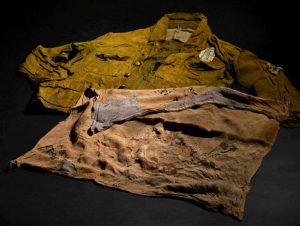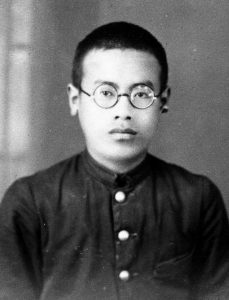Silent Witness: Student uniform and furoshiki wrapping cloth convey image of poverty and diligence to present day
Jan. 31, 2022
by Miho Kuwajima, Staff Writer
The back of the khaki student uniform is torn and on the collar there remains something resembling a bloodstain. Hiroyasu Murakami, then 17, was wearing the uniform on August 6, 1945, when he experienced the atomic bombing in the Hiroshima Prefectural government building in the area of Kakomachi (now part of Kakomachi, written with different kanji characters, in Hiroshima’s Naka Ward), located about 900 meters from the hypocenter. A traditional furoshiki wrapping cloth covered with patches paints a clear picture for those today of a young man who worked hard despite living in poverty.
Mr. Murakami was from the town of Mukaishima-cho (now part of Onomichi City) in Hiroshima Prefecture. Although he had worked for the Tokyo Metropolitan Police Department while going to night school, he moved back to Hiroshima in the fall of 1944. His return to Hiroshima was prompted by his concern about air raids in the capital city. He entered the Third Hiroshima Prefectural Junior High School (present-day, part-time schooling system at Hiroshima Kokutaiji High School) and worked in the human resources section of the internal affairs department for the Hiroshima Prefectural government during the day.
Mr. Murakami was finishing up a night-watch shift on the morning of August 6. After he exchanged greetings with his colleagues arriving to work, he felt a violent shock as if “roaring thunder and an earthquake had arrived at the same time” and became trapped under a concrete pillar. After finally managing to crawl out from under the pillar, he found that the government building had been completely destroyed and that there was no sign of his coworkers.
With serious injuries incurred in the bombing, Mr. Murakami reached a first-aid station in the town of Kaita-cho in Hiroshima Prefecture and witnessed the wounded die one after another. He might very well have sensed his own impending death. The following day, he wrapped medicine provided to him by a doctor in his furoshiki cloth and traveled back to his parents’ house by train and ship. On August 19, suffering from severe dehydration, Mr. Murakami died in agony.
In 1983, Mr. Murakami's older brother, Susumu, donated Mr. Murakami’s student uniform and furoshiki cloth, both of which his parents had cherished as mementos of their son, to the Hiroshima Peace Memorial Museum along with three other items left behind by Mr. Murakami. Among employees of the Hiroshima Prefectural government, 1,141 people are thought to have died in the atomic bombing. Along with the others’, Mr. Murakami's name is engraved onto an A-bomb victims memorial for prefecture staff standing on the site of the former Hiroshima Prefectural government building.
(Originally published on January 31, 2022)
The back of the khaki student uniform is torn and on the collar there remains something resembling a bloodstain. Hiroyasu Murakami, then 17, was wearing the uniform on August 6, 1945, when he experienced the atomic bombing in the Hiroshima Prefectural government building in the area of Kakomachi (now part of Kakomachi, written with different kanji characters, in Hiroshima’s Naka Ward), located about 900 meters from the hypocenter. A traditional furoshiki wrapping cloth covered with patches paints a clear picture for those today of a young man who worked hard despite living in poverty.
Mr. Murakami was from the town of Mukaishima-cho (now part of Onomichi City) in Hiroshima Prefecture. Although he had worked for the Tokyo Metropolitan Police Department while going to night school, he moved back to Hiroshima in the fall of 1944. His return to Hiroshima was prompted by his concern about air raids in the capital city. He entered the Third Hiroshima Prefectural Junior High School (present-day, part-time schooling system at Hiroshima Kokutaiji High School) and worked in the human resources section of the internal affairs department for the Hiroshima Prefectural government during the day.
Mr. Murakami was finishing up a night-watch shift on the morning of August 6. After he exchanged greetings with his colleagues arriving to work, he felt a violent shock as if “roaring thunder and an earthquake had arrived at the same time” and became trapped under a concrete pillar. After finally managing to crawl out from under the pillar, he found that the government building had been completely destroyed and that there was no sign of his coworkers.
With serious injuries incurred in the bombing, Mr. Murakami reached a first-aid station in the town of Kaita-cho in Hiroshima Prefecture and witnessed the wounded die one after another. He might very well have sensed his own impending death. The following day, he wrapped medicine provided to him by a doctor in his furoshiki cloth and traveled back to his parents’ house by train and ship. On August 19, suffering from severe dehydration, Mr. Murakami died in agony.
In 1983, Mr. Murakami's older brother, Susumu, donated Mr. Murakami’s student uniform and furoshiki cloth, both of which his parents had cherished as mementos of their son, to the Hiroshima Peace Memorial Museum along with three other items left behind by Mr. Murakami. Among employees of the Hiroshima Prefectural government, 1,141 people are thought to have died in the atomic bombing. Along with the others’, Mr. Murakami's name is engraved onto an A-bomb victims memorial for prefecture staff standing on the site of the former Hiroshima Prefectural government building.
(Originally published on January 31, 2022)









